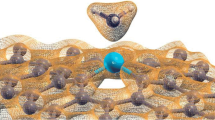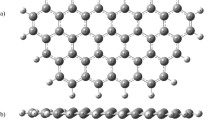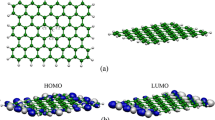Abstract
Exploring and evaluating the potential applications of two-dimensional graphene is an increasingly hot topic in graphene research. In this paper, by studying the adsorption of NO, N2O, and NO2 on pristine and silicon (Si)-doped graphene with density functional theory methods, we evaluated the possibility of using Si-doped graphene as a candidate to detect or reduce harmful nitrogen oxides. The results indicate that, while adsorption of the three molecules on pristine graphene is very weak, Si-doping enhances the interaction of these molecules with graphene sheet in various ways: (1) two NO molecules can be adsorbed on Si-doped graphene in a paired arrangement, while up to four NO2 molecules attach to the doped graphene with an average adsorption energy of −0.329 eV; (2) the N2O molecule can be reduced easily to the N2 molecule, leaving an O-atom on the Si-doped graphene. Moreover, we find that adsorption of NO and NO2 leads to large changes in the electronic properties of Si-doped graphene. On the basis of these results, Si-doped graphene can be expected to be a good sensor for NO and NO2 detection, as well as a metal-free catalyst for N2O reduction.










Similar content being viewed by others
Notes
The adsorption energy of n adsorbate on Si-doped graphene is defined as: E ads = [ E total (nadsorbate-Si-doped graphene)] - n[ E total (adsorbate)] - [ E total Si-doped graphene)]/n, where E total is the total energy of the studied system and n is the number of the adsorbate
see footnote 1
References
Novoselov KS, Geim AK, Morozov SV, Jiang D, Zhang Y, Dubonos SV, Grigorieva IV, Firsov AA (2004) Science 306:666–669
Geim AK (2009) Science 324:1530–1534
Rao CNR, Sood AK, Subrahmanyam KS, Govindaraj A (2009) Angew Chem Int Edn 48:7752–7777
Rao CNR, Biswas K, Subrahmanyam KS, Govindaraj A (2009) J Mater Chem 19:2457–2469
Neto AHC, Guinea F, Peres NMR, Novoselov KS, Geim AK (2009) Rev Mod Phys 81:109–162
Taghioskoui M (2009) Mater Today 12:34–37
Zhu Y, Murali S, Cai W, Li X, Suk JW, Potts JR, Ruoff RS (2010) Adv Mater 22:3906–3924
Schedin F, Geim AK, Moeozov SV, Hill EW, Blake P, Katsnelson MI, Novoselov KS (2007) Nat Mater 6:652–655
Barbolina II, Novoselov KS, Morozov SV, Dubonos SV, Missous M, Volkov AO, Christian DA, Grigorieva IV, Geim AK (2006) Appl Phys Lett 88:013901
Allen MJ, Tung VC, Kaner RB (2010) Chem Rev 110:132–145
Loh KP, Bao Q, Ang PK, Yang J (2010) J Mater Chem 20:2277–2289
Terronesa M, Botello-Méndez AR, Campos-Delgado J, López-Urías F, Vega-Cantú YI, Rodríguez-Macías FJ, Elías AL, Muñoz-Sandoval E, Cano-Márquez AG, Charlier J-C, Terrones H (2010) Nanotoday 5:351–372
Abergel DSL, Apalkov V, Berashevich J, Ziegler K, Chakraborty T (2010) Adv Phys 59:261–482
Choi W, Lahiri L, Seelaboyina R, Kang YS (2010) Crit Rev Solid State Mater Sci 35:52–71
Novoselov KS, Geim AK, Morozov SV, Jiang D, Katsnelson MI, Grigorieva IV, Dubonos SV (2005) Firsov AA. Nature 438:197–200
Zhang Y, Tan Y, Stormer HL, Kim P (2005) Nature 438:201–204
Danneau R, Wu F, Craciun MF, Russo S, Tomi MY, Salmilehto J, Morpurgo AF, Hakonen P (2008) J Phys Rev Lett 100:196802
Wehling TO, Noveselov KS, Morozov SV, Vdovin EE, Katsnelson MI, Geim AK, Lichtenstein AI (2008) Nano Lett 8:173–177
Goldoni A, Larciprete R, Petaccia L, Lizzit S (2003) J Am Chem Soc 125:11329–11333
Leenaerts O, Partoens B, Peeters FM (2008) Phys Rev B 77:125416
Dai J, Giannozzi P, Yuan J (2009) Surf Sci 603:3234–3238
Johnson JJ, Behnam A, Pearton SJ, Ural A (2010) Adv Mater 22:4877–4880
Kaniyoor A, Jafri RI, Arokiadoss T, Ramaprabhu S (2009) Nanoscale 1:382–386
Dai J, Yuan J, Giannozzi P (2009) Appl Phys Lett 95:232105
Zhang YH, Chen YB, Zhou KG, Liu CH, Zeng J, Zhang HL, Peng Y (2009) Nanotechnology 20:185504
Ao ZM, Yang J, Li S, Jiang Q (2008) Chem Phys Lett 461:276–279
Francesco FAP, Kelly FJ, Holgate ST (2005) Air Quality Guidelines Global Update; World Health Organization
Trogler WC (1999) Coord Chem Rev 187:303–327
Duce R et al (2008) Science 320:893–897
Ravishankara AR, Daniel JS, Portmann RW (2009) Science 326:123–125
Berger C, Song ZM, Li TB, Li XB, Ogbazghi AY, Feng R, Dai ZT, Marchenkov AN, Conrad EH, First PN, de Heer WA (2004) J Phys Chem B 108:19912–19916
Delley B (1990) J Chem Phys 92:508–517
Delley B (2000) J Chem Phys 113:7756–7764
Perdew JP, Burke K, Ernzerhof M (1996) Phys Rev Lett 77:3865
Wu X, Zeng XC (2009) Nano Lett 9:250–256
Jiang D, Sumpter BG, Dai S (2006) J Phys Chem B 110:23628–23632
Choi WI, Jhi SH, Kim K, Kim YH (2010) Phys Rev B 81:085441
Manna AK, Pati SK (2009) Chem Asian J 4:855–860
Dai J, Yuan J, Giannozzi P (2010) Phys Rev B 81:165414
Suggs K, Reuven D, Wang XQ (2011) J Phys Chem C 115:3313–3317
Monkhorst HJ, Pack JD (1976) Phys Rev B 13:5188–5192
Hirshfeld FL (1977) Theor Chim Acta 44:129–138
Davidson ER, Chakravorty S (1992) Theor Chim Acta 83:319–330
Meister J, Schwarz WHE (1994) J Phys Chem 98:8245–8252
Wiberg KB, Rablen PR (1993) J Comput Chem 14:1504–1518
Verstraete M, Gonze X (2003) Phys Rev B 68:195123
Wu XJ, Zeng XC (2006) J Chem Phys 125:044711
Bultinck P, Alsenoy VC, Ayers PW, Carbó-Dorca R (2007) J Chem Phys 126:144111
Boys SF, Bernardi F (1970) Mol Phys 19:553
Inada Y, Orita H (2008) J Comput Chem 29:225–232
Cobian M, Iniguez J (2008) J Phys Condens Matter 20:285212
Ataca C, Aktürk E, Ciraci S, Ustunel H (2008) Appl Phys Lett 93:043123
de Andres PL, Ramírez R, Vergés JA (2008) Phys Rev B 77:045403
Cabria I, López MJ, Alonso JA (2005) J Chem Phys 123:204721
Okamoto Y, Miyamoto Y (2001) J Phys Chem B 105:3470–3474
Wu XJ, Gao Y, Zeng XC (2008) J Phys Chem C 112:8458–8463
Perdew JP, Wang Y (1992) Phys Rev B 45:13244–13249
Cruz-Silva E, López-Urías F, Muñoz-Sandoval E, Sumpter BG, Terrones H, Charlier J-C, Meunier V, Terrones M (2009) ACS Nano 3:1913–1921
Pietrzyk P, Zasada F, Piskorz W, Kotarba A, Sojka Z (2007) Catal Today 119:219–227
Pietrzyk P, Gil B, Sojka Z (2007) Catal Today 126:103–111
Hadjiivanov K (2000) Catal Rev Sci Eng 42:71–144
Dean JA (1992) Lange’s Chemistry Handbook, 15th edn. New York, McGraw-Hill
Jhi SH, Louie SG, Cohen ML (2000) Phys Rev Lett 85:1710–1713
Parr RG, Yang W (1989) Density-functional theory of atoms and molecules. Oxford University Press, New York
Acknowledgments
We gratefully acknowledge support of this research by the Key Program Projects of the National Natural Science Foundation of China (No 21031001), the National Natural Science Foundation of China (No 20971040), the Cultivation Fund of the Key Scientific and Technical Innovation Project, Ministry of Education of China (No 708029), the Key Program Projects of the Province Natural Science Foundation of Heilongjiang Province (No. ZJG0602-01), the National Basic Research Priority Program (No. 2007CB914104), the Committee of Education of Heilongjiang Province (No. 11541095), the Scientific Research Foundation for Doctor of Harbin Normal University (08XKYL38), and Heilong Jiang Postdoctoral Funds for scientific research initiation. The authors would like to express their gratitude to the reviewers for raising invaluable comments and suggestions.
Author information
Authors and Affiliations
Corresponding author
Supplementary material available
Below is the link to the electronic supplementary material.
Figure S1
Spin densities of a the adsorbed Si-doped graphene by an individual NO molecule, and b the free NO molecule. The isovalue is 0.025 au. (DOC 106 kb)
Figure S2
Highest occupied molecular orbitals (HOMOs) of Si-doped graphene after adsorbing one NO molecule. The isovalue is 0.025 au. (DOC 61 kb)
Figure S3
a Spin densities, and b HOMOs of the adsorbed Si-doped graphene by an individual NO2 molecule. The isovalue is 0.025 au. (DOC 274 kb)
Rights and permissions
About this article
Cite this article
Chen, Y., Gao, B., Zhao, JX. et al. Si-doped graphene: an ideal sensor for NO- or NO2-detection and metal-free catalyst for N2O-reduction. J Mol Model 18, 2043–2054 (2012). https://doi.org/10.1007/s00894-011-1226-x
Received:
Accepted:
Published:
Issue Date:
DOI: https://doi.org/10.1007/s00894-011-1226-x




